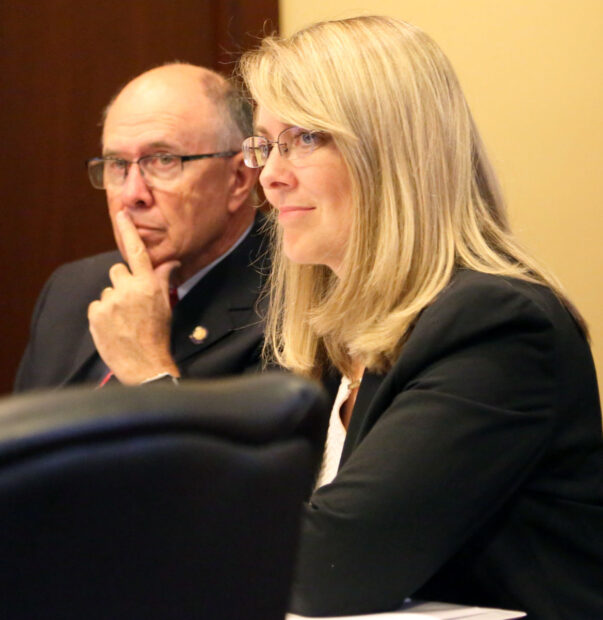Idaho legislators and education leaders met Tuesday to discuss rewriting Idaho’s public school funding formula and, as was expected, the meeting did not produce fireworks or breakthroughs.
Instead, most of the four-hour meeting was spent recapping spending history and reviewing Idaho’s current funding formula, which members acknowledged is complicated and deserves a thorough and lengthy review and rewrite process.
The 2016 Legislature decided it is time to modernize the 22-year-old funding formula to reflect changes in the K-12 system — from online learning to classroom technology to charter schools. So it formed a legislative “interim committee” to review the formula and report back its findings to the 2017 Legislature.

“We need to find out what’s broken,” said committee co-chair and Senate Assistant Majority Leader Chuck Winder, R-Boise.
After recap presentations, committee members shared their thoughts on school funding.
Sen. Steven Thayn, R-Emmett, questioned if a total rewrite was necessary but said the formula could use simplifying.
Idaho Falls Republican Rep. Wendy Horman, a member of the budget-writing Joint Finance-Appropriations Committee and co-chair of the interim committee, disagreed with Thayn. “There’s got to be a better way,” she said.
Committee member and House Speaker Scott Bedke, R-Oakley, drove home what he thinks to be the critical component. “Our work here needs to lead to better education outcomes,” Bedke said. “That is a problem as far as I’m concerned.”
Most committee members shared their ideas about Idaho’s funding formula or stated topics that should be considered. The below concepts would be the outline for future discussions:
- Count students (enrollment and mobility) instead of average daily attendance.
- Promote flexibility in spending for districts.
- Simplify the formula.
- Create an accountability system that matches the formula to outcomes.
- Carve out health care costs from the discretionary funding line item.
- Consider long-term goals and mastery-based learning models.
- Value recruitment and retention of teachers.
- Include school construction costs (bonds) and levies (local funding).
- Adjust to the changing climate of school choice and mobility.
- Request resources and tools that may be needed for the committee review.
- Consider school staffing needs.
“Moving toward a mastery-based learning system could complicate how we allocate money,” said Deputy Superintendent Pete Koehler, who represented the State Department of Education on the committee in Superintendent Sherri Ybarra’s absence.
Horman said: “We need to grant flexibility to districts and trust our administrators and teachers to innovate. Strings tied to state dollars with line items reduces flexibility.”
Thayn said: “Instead of funding the institution we should be funding students.”
Committee members heard from Michael Griffith of the Education Commission of the States, who shared highlights of nationwide education funding practices and what he considers to be “high-quality” funding formula components.
Griffith said Maryland and Massachusetts have two of the nations most admired new funding formulas and both are tied to student achievement. In Maryland, each of about 30 districts sign an “education agreement” with the state. The agreements specify goals for student achievements and the plans to reach those goals.
“Goals and outcomes for learning are tied to the funding system,” Griffith said.
Idaho’s current public education funding formula is based on three methods of allocation: district size (smaller districts get more money from the state because of fixed costs), teacher experience (a teacher’s salary increases with years and credits gained) and student population (high school students cost more to educate).
About 30 people attended Tuesday’s meeting.
What is next for the interim committee
- The State Board of Education will develop a survey to gather stakeholder data to enhance upcoming committee conversations. Several committee members volunteered to join a working group to write survey questions. Senate Education Committee Chairman Dean Mortimer, R-Idaho Falls, will chair the working group.
- The State Department of Education will collect more historic funding data for committee members.
- The group targeted Aug. 30, Sept. 27 and Oct. 17 as possible future meeting times.
- Horman recommended the Aug. 30 meeting should include testimony time for stakeholders. Winder recommended the September and October meetings take place in the North and East Idaho.
- The J.A. and Kathryn Albertson Family Foundation offered to pay for resources the committee may need to complete its work. Members were undecided on what resources or tools they might need and about using private funds for legislative research. “Private contribution could help us accomplish our goals,” Winder said.
More reading: Here’s our in-depth analysis of the school funding formula issue, with a look back to 1994.
Disclosure: Idaho Education News is funded by the J.A. and Kathryn Albertson Family Foundation.
